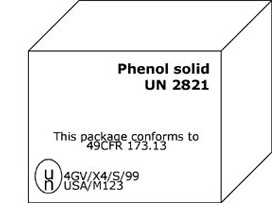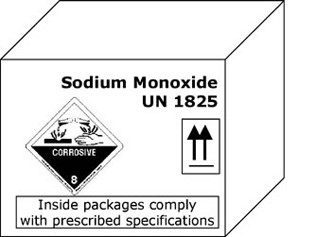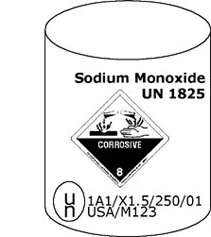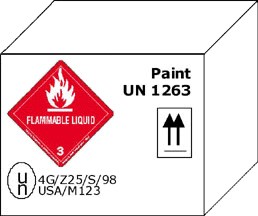
Hazardous Materials (FedEx Ground): how to ship
Hazardous Materials (FedEx Ground): how to ship
Get an overview of hazardous materials shipping information, including how to ship batteries and details on services and restrictions. Contact your FedEx account executive to become an approved hazardous materials shipper.
Shipping dangerous goods via FedEx Express? Start here.
For complete information on shipping hazardous materials via FedEx Ground, see the FedEx Ground Hazardous Materials Shipping Guide.
- All hazardous materials shipments must be properly packaged and prepared under Title 49 Code of Federal Regulations (49 CFR). We do not accept hazardous materials prepared under International Air Transport Association (IATA) or International Civil Aviation Organization (ICAO) regulations.
- If you're submitting packages under a U.S. Department of Transportation (DOT) special permit, you must provide a copy of the special permit paperwork to the FedEx Ground facility accepting your shipment.
- You must be prepared to provide a copy of the Material Safety Data Sheet (MSDS) for your materials upon our request.
Note: This information is provided to FedEx Ground as a tool and should be used in conjunction with and in addition to the requirements of state and federal governments. Customers are responsible for ensuring their shipments comply with all applicable state and federal regulations. Learn more about shipping dangerous goods via FedEx Express.
Service restrictions
- Before you can begin shipping hazardous materials via FedEx Ground, you must be approved (see How to Qualify). Contact your FedEx account executive or call FedEx Customer Service at 1.800.463.3339 (say “hazardous materials”) for more information.
- We ship hazardous materials, including Limited Quantity materials, via FedEx Ground® within the contiguous U.S. Hazardous materials, including Limited Quantity materials, cannot be shipped to, from or within Alaska or Hawaii. Limited Quantity can be shipped to Canada. You cannot, however, ship ammunition, cartridge small arms and cartridge power devices to Canada.
- FedEx Ground® Call Tag service is not available for hazardous materials shipments.
- Our money-back guarantee may not apply to shipments that are not properly prepared in accordance with DOT regulations and FedEx Ground requirements.
- Hazardous materials, including Limited Quantity materials and dry ice, are not accepted at FedEx Office® Print and Ship Centers, FedEx Ship Center® locations, FedEx Office® Ship Centers, FedEx Authorized ShipCenter® locations, FedEx® Drop Boxes or unstaffed FedEx locations. Shipments containing hazardous materials, including Limited Quantity materials and dry ice, must be tendered to FedEx Ground via a scheduled pickup at the customer location. FedEx Office Print and Ship Centers will accept shipments containing lithium batteries shipped according to 49 CFR 173.185. See FedEx® services available to ship dangerous goods for information on dropping off FedEx Express® shipments that contain lithium batteries (look under Restrictions).
- Packages containing hazardous materials cannot exceed 70 lbs. The maximum volume is 8 gallons.
- When shipping dry ice packages via FedEx Ground beginning April 20, 2020, the following must be adhered to:
- Shippers offering dry ice must notify the driver at pickup.
- Packages must be marked that they contain dry ice; see label examples in the Marking and Labeling section below.
- The dry ice option in automation must be utilized for shipments containing dry ice.
Hazardous materials and dry ice
| Service is available from U.S. origins only (all states except Alaska and Hawaii). | |||
| Commodity | Contiguous U.S. | Alaska and Hawaii | Canada |
|---|---|---|---|
| Hazardous Materials |
Yes | No |
No |
| Limited Quantity |
Yes | No | Yes1 |
| Dry Ice |
Yes | No | Yes2 |
1Call 1.800.463.3339 and say “hazardous materials” to confirm availability in advance.
2You can ship dry ice to Canada if your shipment meets the following three conditions:
- The dry ice is used as a refrigerant in a small container with a capacity of 450 liters or less.
- You indicate “Dry ice as refrigerant” on the documentation accompanying the container.
- The container is designed and constructed to permit the release of carbon dioxide, to prevent a build-up of pressure that could rupture the container.
Materials restrictions
We do not accept for delivery:
- Hazardous waste, including, but not limited to, used hypodermic needles or syringes transported for sterilization, recycling, disposal or for any other purpose, or other medical waste
- Hazardous substances in reportable quantities
- Infectious or non-infectious human or animal cells, tissue, bodily fluids, blood, blood products, plasma, or any other material derived from human or animal blood whether in liquid or solid form
- Biohazards
- Regulated or nonregulated diagnostic cultures, specimens or samples, whether infectious or noninfectious
- Used healthcare products as defined in Title 49 of the Code of Federal Regulations
- Any materials regulated as UN 2814, UN 2900, UN 3373 and UN 3291
- Damaged or defective batteries
- Material marked as an “inhalation hazard"
- Fireworks
- Human corpses, cremated or disinterred human remains, and animal carcasses
Refer to column 9 of the FedEx Ground Hazardous Materials Table for additional restrictions and requirements.
Hazardous materials security
Due to a change in the federal regulations governing hazardous materials (HM-232), shippers and carriers are required to develop and implement a security plan addressing risks related to the transportation of hazardous materials. We have such a plan in place and are in full compliance with this regulation, along with the security-training requirements specified in 49 CFR 172.704.
Note: Due to the sensitive nature of this information, we cannot make a copy of our security plan available.
FedEx Ground accepts certain classes and divisions of hazardous materials for transport. Before you ship, please refer to the following list to ensure your packages contain only accepted hazardous materials.
Accepted hazardous materials
| Class | Name | Label Code/Label |
|---|---|---|
| 1.41 | Explosives | 1.4/Explosive 1.4 |
| 1.6 | Explosives | 1.6/Explosive 1.6 |
| 2.1 | Flammable Gas | 2.1/Flammable Gas |
| 2.2 | Non-Flammable Gas | 2.2/Non-Flammable Gas |
| 3 | Flammable Liquid | 3/Flammable Liquid |
| 4.1 | Flammable Solid | 4.1/Flammable Solid |
| 5.1 | Oxidizer | 5.1/Oxidizer |
| 5.2 | Organic Peroxide | 5.2/Organic Peroxide |
| 7 | Radioactive Material | 7/Radioactive White I |
| 8 | Corrosive Material | 8/Corrosive |
| 9 | Miscellaneous Hazardous Materials | 9/Class 9 |
1Except fireworks.
Important: Based on the nature of the material or U.S. Department of Transportation (DOT) shipping regulations, FedEx Ground may not accept certain "accepted" hazardous materials. Always refer to column 9 of the FedEx Ground Hazardous Materials Table for additional restrictions and requirements.
Prohibited hazardous materials
1We will handle these materials only when packaged in special exemption packaging or when packaged in accordance with DOT exception 49 CFR 173.13, which does not require DOT diamond-shaped hazard labels.
All packages must be properly marked in accordance with Title 49 Code of Federal Regulations (49 CFR) requirements. We require all packages to have a minimum of four package markings:
- Shipper’s address
- Recipient’s address
- Proper shipping name as designated by the U.S. Department of Transportation (DOT)
- The UN/NA Identification Number
Depending on the contents of your shipment, additional markings may be required:
- For certain types of explosives and safety devices (formerly classified as airbag modules, airbag inflators and seat belt pretensioners), you are required to provide EX numbers, national stock numbers or product codes in accordance with 49 CFR 173.320 on your packaging and/or shipping forms. List the EX numbers, national stock numbers or product codes in the Type DOT Label(s) Required, Ltd. Qty. or Special Permit field of the OP-900LL or OP-900LG, and the Hazardous Materials Certification.
- The DOT allows certain types of hazardous materials to be transported under a special permit. The special permit number must be marked legibly on the outside of your packaging ("DOT-SP-9168," for example), and in the Type DOT Label(s) Required, Ltd. Qty. or Special Permit field of the OP-900LL or OP-900LG, and the Hazardous Materials Certification.
- When shipping hazardous materials under exception 49 CFR 173.13, mark “This package conforms to 49 CFR 173.13” on your packaging and in the Type DOT Label(s) Required, Ltd. Qty. or Special Permit field of the OP-900LL or OP-900LG, and the Hazardous Materials Certification.
- A United Nations Performance Oriented Packaging (UN POP) code is embossed on the outside of specification packaging. These codes vary depending on the type of packaging and its performance level (see Packaging for further details). The UN POP markings (example: UN 4G/X12/S/99/USA/M123) must be permanently marked on the outer package and should never be covered or obstructed by labels or other information.
- When overpacking (using an outer package), you must mark "overpack" on the outer package. This can be handwritten or affixed by label on the packaging.
- All lighters or lighter refills identified as UN 1057 must have the appropriate "LAA" number marked on the packaging, OP-900LL or OP-900LG, and the Hazardous Materials Certification.
All liquid hazardous materials and Class 7 Radioactive must be legibly marked, with package orientation arrows on two opposite, vertical sides of the package (hand-drawn or printed on a label). Your markings must conform pictorially to ISO Standard 780-1985: two upward arrows with a line underneath, enclosed within a rectangle (the rectangular border is optional).
Packages containing hazardous materials must be properly labeled. The diamond-shaped hazard label, which indicates the hazard class and division of the material you’re shipping, is the most commonly used label. It must be displayed on packaging of contrasting color.
Some hazardous materials present more than one hazard. When shipping these materials, the subsidiary hazard label must be displayed within 6 inches of the primary hazard label on your packaging.
Packages must be marked that they contain dry ice. Example labels are below:



Exceptions to labeling:
- Packages shipped as a Limited Quantity may be exempt from the labeling requirements.
- Packages shipped under a DOT special permit may also be exempt from labeling requirements.
- Packages prepared under 49 CFR 173.13 do not require a diamond-shaped hazard label.
All hazardous materials must be packaged in United Nations Performance Oriented Packaging (UN POP) except when non-specification packaging is authorized by Title 49 Code of Federal Regulations (49 CFR). All packaging must meet the requirements set out in 49 CFR 173.24 and 49 CFR 173.24a. Packaging that is not in new or "like new" condition will not be accepted. In addition, the following requirements apply:
- Fiberboard non-specification packaging and outer packaging must meet the following requirements:
- For packages weighing up to 20 lbs., the minimum requirements are a 200-lb. bursting test or 32-edge crush test package.
- For packages weighing 21–50 lbs., the minimum requirements are a 250-lb. bursting test or 44-edge crush test package.
- For packages weighing 51–70 lbs., the minimum requirements are a 275-lb. bursting test or 55-edge crush test package.
- All containers with friction-fitted lids must have a retaining ring around the lid or:
- Six lid clips (for gallon containers)
- Five lid clips (for quart containers)
- Four lid clips (for pint containers)
- Hazardous materials cannot be shipped in FedEx® packaging.
- When required, all Class 2 cylinders must be placed inside an overpack (outer package) marked either "Overpack" or, if required by 49 CFR 173.301, “Inside packages comply with prescribed specifications.”
- Hazardous materials cannot be banded, strapped or taped to form a bundle.
- FedEx Ground does not accept pails or drums more than 8 gallons (32 liters). All pails or drums must be UN POP. We will accept authorized pails or drums as single packaging.
- We will accept up to three different compatible hazardous materials inside one UN POP specification package or in an overpack containing the required UN POP specification package. The materials must be packaged separately then placed in one outer package.
- We do not accept cryogenic liquids unless properly prepared and packaged under exception 49 CFR 173.320. FedEx Ground does not accept flammable (Class 2.1) cryogenic liquids.
- FedEx Ground does not accept radioactive fissile material unless properly prepared and packaged under exception 49 CFR 173.453.
- Combination packaging containing hazardous materials cannot exceed the inner-container requirements. The maximum size, number and total weight of glass, plastic or metal inner containers allowed in any one package are listed below:
| Type of Container | Max. Unit Size | Max. Number of Units | Max. Volume per Carton | Max. Net Weight per Package |
|---|---|---|---|---|
| Glass | 1/2 liter | 121 | 3 liters (12 pints) | Net 25 lbs. |
|
1 liter (1 quart) | 6 | 6 liters (6 quarts) | Net 25 lbs. |
|
2 liters (1/2 gallon) | 4 | 8 liters (2 gallons) | Net 25 lbs. |
|
4 liters (1 gallon) | 2 | 8 liters (2 gallons) | Net 25 lbs. |
| Plastic | 8 liters (2 gallons) | 41 | 16 liters (4 gallons) | Net 50 lbs. |
| Metal | 4 liters (1 gallon) | 41 | 16 liters (4 gallons) | Net 50 lbs. |
1For glass unit sizes of less than 1/2 liter (1 pint) and plastic or metal unit sizes of less than 4 liters (1 gallon), the combination packaging cannot exceed the maximum volume or weight per inner carton or inner package.
All packages must have a properly prepared hazardous materials shipping form OP-900LL or OP-900LG attached on the top of the outer package next to the address label and must include “To” (recipient) and “From” (shipper) addresses. The following illustrations are for information purposes only.
Example No. 1: Flammable Liquid (Class 3)
Example No. 2: Toxic (Class 6.1)
Option 1: DOT Special Permit



Option 2: 49 CFR 173.13



Note: For either option, you do not need to affix the DOT diamond-shaped hazard label.
Example No. 3: Flammable Gas (Class 2.1)



Note: All Class 2 materials (except Lighters, UN 1057) must be properly overpacked (packed inside an outer container).
Example No. 4: Authorized Single Packaging
Option 1: Overpacked (49 CFR 173.25)



Option 2: Single (Stand-alone)



Example No. 5: Limited Quantity Shipments Without Shipping Papers



Note: FedEx Ground will accept this marking only when you are shipping limited quantities without shipping papers.
